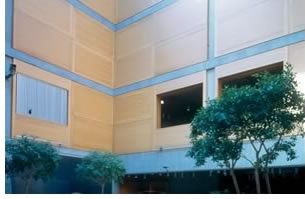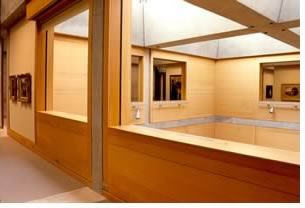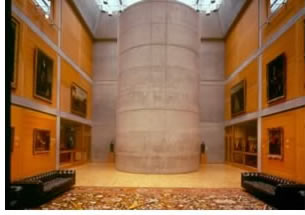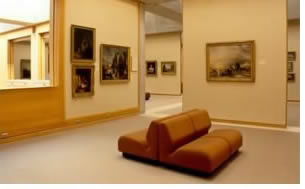

12/2004
AIA Gold Medalist Louis I. Kahn’s Yale Center for British Art in New Haven, Conn., was selected by the Institute Honor Awards for Architecture Jury on November 19 to receive the 2005 Twenty-five Year Award, honoring structures of enduring significance that were completed 25 to 35 years ago. Begun in 1973, one year before Kahn’s death, and opened to the public in 1977, the Yale Center for British Art is among Kahn’s finest structures.
 When
the center received an AIA Honor Award in 1978, the jury noted, “This
building is a gentle urbane masterpiece. It offers a quiet foil to its
more demonstrative neighbors and, from the interior, frames and augments
them. The small specialty shops tucked into its façade give vitality
and continuity to the pedestrian character of the street. The interior
spaces are well planned for easy movement through the exhibits. They
frequently reveal surprising glimpses of one another. A quiet feeling
of delight grows within you with the discovery of each new space, and
the manner in which the whole is subtly revealed has an ever-surprising
complexity.”
When
the center received an AIA Honor Award in 1978, the jury noted, “This
building is a gentle urbane masterpiece. It offers a quiet foil to its
more demonstrative neighbors and, from the interior, frames and augments
them. The small specialty shops tucked into its façade give vitality
and continuity to the pedestrian character of the street. The interior
spaces are well planned for easy movement through the exhibits. They
frequently reveal surprising glimpses of one another. A quiet feeling
of delight grows within you with the discovery of each new space, and
the manner in which the whole is subtly revealed has an ever-surprising
complexity.”
 Andrea
O. Dean wrote in the AIA Journal, “The
new Yale Center for British Art serves as a fitting summation of [Kahn’s]
work and ideas...In fact, many of the most forward-looking aspects
of this building...are adaptations of Beaux-Arts principles firmly
repudiated by most ‘Modern’ architects. Kahn returned to
the use of natural light, though employing it in a completely novel way.
Instead of undifferentiated spaces, he created rooms complementing the
scale and tone of Paul Mellon’s collection, never overwhelming
it.”
Andrea
O. Dean wrote in the AIA Journal, “The
new Yale Center for British Art serves as a fitting summation of [Kahn’s]
work and ideas...In fact, many of the most forward-looking aspects
of this building...are adaptations of Beaux-Arts principles firmly
repudiated by most ‘Modern’ architects. Kahn returned to
the use of natural light, though employing it in a completely novel way.
Instead of undifferentiated spaces, he created rooms complementing the
scale and tone of Paul Mellon’s collection, never overwhelming
it.”
Kahn’s first major commission
Endowed by Mellon, the Yale Center for British Art was erected to house
the largest, most comprehensive collection of British art outside the
U.K. Located across the street from the Yale University Art Gallery,
Kahn’s first major commission, the Center for British Art, was
the first museum in the U.S. to incorporate retail shops on the street.
A monumental yet restrained civic structure, the center’s taut
exterior of matte steel and reflective glass becomes animated in the
sunlight. “On a gray day the building looks like a moth; on a
sunny day, like a butterfly—just as Kahn once predicted,” wrote
Louis R. Pounders, FAIA, and James F. Williamson, AIA, in their nomination
letter.
 The geometrical interior is designed around two courtyards, one housing
a massive concrete cylinder concealing a spiral stair that dominates
the library courtyard. Travertine flooring, Belgian linen wall coverings,
white oak woodwork, stainless steel panels and ducts, and exposed concrete
structural elements complete the restrained and formal palette of materials.
As Vincent Scully observed, “the effect is rather Miesian, and
suggests a kind of dignified, if reductive, Classicism.”
The geometrical interior is designed around two courtyards, one housing
a massive concrete cylinder concealing a spiral stair that dominates
the library courtyard. Travertine flooring, Belgian linen wall coverings,
white oak woodwork, stainless steel panels and ducts, and exposed concrete
structural elements complete the restrained and formal palette of materials.
As Vincent Scully observed, “the effect is rather Miesian, and
suggests a kind of dignified, if reductive, Classicism.”
 Awash with natural light
Awash with natural light
Kahn believed that natural light is essential to fully appreciate the
works contained within. Hence, the majestic four-story entrance courtyard
is awash in natural light. That light is then filtered into the adjoining
galleries through unglazed interior windows. Skylights provide illumination
for the top-floor galleries; angled louvers and baffles in the truncated,
pyramidal, concrete coffers block bluish north light and screen ultraviolet
rays, admitting larger quantities of light when the sun is low than
when it is higher in the sky. The jury noted, “This building
reflects Kahn’s continuous search for simplicity and the use
of daylight to define space. It is one of the quietest expressions
of a great building ever seen—so rewarding and exhilarating when
you step inside. The materiality and the language of the wood framed
in stainless steel, concrete, and natural linen is still a delight
for the eye.”
 Louis
I. Kahn, FAIA, emigrated to the U.S. from Estonia at the age of four.
After receiving his BArch from the University of Pennsylvania, Kahn taught
at Yale from 1947 to 1957. During that time, he was also resident architect
at the American Academy in Rome. While there, he traveled throughout
Italy, Egypt, and Greece, recording historic architecture in drawings
and sketches. After his tenure at Yale, Kahn became dean of the School
of Architecture at the University of Pennsylvania. In the mid-1950s,
Kahn rose to prominence in the field, receiving significant awards and
commissions. Sadly, he died alone and unrecognized at the zenith of his
career. Some of Kahn’s most memorable structures
include the Salk Institute for Biological Studies, La Jolla, Calif.;
the Kimball Art Museum, Ft. Worth; the National Assembly, Dhaka,
Bangladesh; and the Phillips Exeter Library, Exeter, N.H.
Louis
I. Kahn, FAIA, emigrated to the U.S. from Estonia at the age of four.
After receiving his BArch from the University of Pennsylvania, Kahn taught
at Yale from 1947 to 1957. During that time, he was also resident architect
at the American Academy in Rome. While there, he traveled throughout
Italy, Egypt, and Greece, recording historic architecture in drawings
and sketches. After his tenure at Yale, Kahn became dean of the School
of Architecture at the University of Pennsylvania. In the mid-1950s,
Kahn rose to prominence in the field, receiving significant awards and
commissions. Sadly, he died alone and unrecognized at the zenith of his
career. Some of Kahn’s most memorable structures
include the Salk Institute for Biological Studies, La Jolla, Calif.;
the Kimball Art Museum, Ft. Worth; the National Assembly, Dhaka,
Bangladesh; and the Phillips Exeter Library, Exeter, N.H.
The Yale Center for British Art is the fifth Kahn building to receive the Twenty-five Year Award. Both building and architect will be honored at the American Architectural Foundation’s Accent on Architecture gala February 11, 2005, in Washington D.C.
Copyright 2004 The American Institute of Architects.
All rights reserved. Home Page ![]()
![]()
 |
||
Pellechia & Meyers, formed in 1973 by Anthony Pellecchia and Marshall Meyers, project architects at the time in the office of Louis I. Kahn, completed the Yale Center for British Art after Kahn's death in 1974.
|
||
